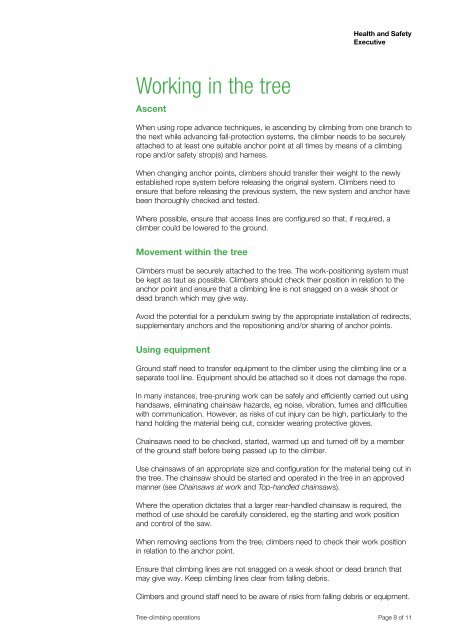Tree-climbing operations AFAG401 - HSE
Tree-climbing operations AFAG401 - HSE
Tree-climbing operations AFAG401 - HSE
You also want an ePaper? Increase the reach of your titles
YUMPU automatically turns print PDFs into web optimized ePapers that Google loves.
Health and Safety<br />
Executive<br />
Working in the tree<br />
Ascent<br />
When using rope advance techniques, ie ascending by <strong>climbing</strong> from one branch to<br />
the next while advancing fall-protection systems, the climber needs to be securely<br />
attached to at least one suitable anchor point at all times by means of a <strong>climbing</strong><br />
rope and/or safety strop(s) and harness.<br />
When changing anchor points, climbers should transfer their weight to the newly<br />
established rope system before releasing the original system. Climbers need to<br />
ensure that before releasing the previous system, the new system and anchor have<br />
been thoroughly checked and tested.<br />
Where possible, ensure that access lines are configured so that, if required, a<br />
climber could be lowered to the ground.<br />
Movement within the tree<br />
Climbers must be securely attached to the tree. The work-positioning system must<br />
be kept as taut as possible. Climbers should check their position in relation to the<br />
anchor point and ensure that a <strong>climbing</strong> line is not snagged on a weak shoot or<br />
dead branch which may give way.<br />
Avoid the potential for a pendulum swing by the appropriate installation of redirects,<br />
supplementary anchors and the repositioning and/or sharing of anchor points.<br />
Using equipment<br />
Ground staff need to transfer equipment to the climber using the <strong>climbing</strong> line or a<br />
separate tool line. Equipment should be attached so it does not damage the rope.<br />
In many instances, tree-pruning work can be safely and efficiently carried out using<br />
handsaws, eliminating chainsaw hazards, eg noise, vibration, fumes and difficulties<br />
with communication. However, as risks of cut injury can be high, particularly to the<br />
hand holding the material being cut, consider wearing protective gloves.<br />
Chainsaws need to be checked, started, warmed up and turned off by a member<br />
of the ground staff before being passed up to the climber.<br />
Use chainsaws of an appropriate size and configuration for the material being cut in<br />
the tree. The chainsaw should be started and operated in the tree in an approved<br />
manner (see Chainsaws at work and Top-handled chainsaws).<br />
Where the operation dictates that a larger rear-handled chainsaw is required, the<br />
method of use should be carefully considered, eg the starting and work position<br />
and control of the saw.<br />
When removing sections from the tree, climbers need to check their work position<br />
in relation to the anchor point.<br />
Ensure that <strong>climbing</strong> lines are not snagged on a weak shoot or dead branch that<br />
may give way. Keep <strong>climbing</strong> lines clear from falling debris.<br />
Climbers and ground staff need to be aware of risks from falling debris or equipment.<br />
<strong>Tree</strong>-<strong>climbing</strong> <strong>operations</strong> Page 8 of 11

















